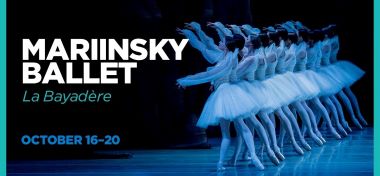A TEMPLE FOR BALLET
Segerstrom Hall is now filled with the gorgeous melodies of a late-blooming classical ballet from 1877. With an infectious score by Ludwig Minkus, La Bayadère premiered in St. Petersburg, Russia in 1877 at the Imperial Russian Ballet, choreographed by the great Marius Petipa (who would go on to greater glory with Tchaikovsky). That same company — now known of course as the Mariinsky or Kirov Ballet — has arrived in Southern California with the very same ballet, one of the most gorgeous examples of pure academic ballet. There have been revisions over the century, and in 1941, Vladimir Ponomarev and Vakhtang Chabukiani staged a new production for the Kirov/Mariinsky Ballet, which is the production you get here.
This extravaganza of a swirling spectacle transports us to a mythic India — and a silly story fully justified by the music that tells it. In this mystic realm of white Mughal palaces and rose-red fortresses, our hero is the low-caste warrior prince Solor (a splendid Vladimir Shklyarov, strong and slinky), who has killed a tiger and saved a village. But he’s also fallen in love with the beautiful and forbidden bayadère, or temple dancer, Nikiya (elegantly sensual standout Maria Khoreva), much to the rage of the implacable High Brahmin (formidable Soslan Kulaev) who also craves the delectable Nikiya.
To provide more swift-moving complications, the bejeweled Rajah (Andrey Yakovlev) rewards tiger-killing Solor with the hand of his daughter Gamzatti (quicksilver Anastasia Nuikina), a princess who’s not above using an asp against her rival if it means separating her comely Solor from Nikiya’s irresistible charms; unscrupulous Gamzatti gets help from her servant Aya (Lira Khuslanova), and the snake takes Nikiya’s life — and ruins a perfectly good party with a bunch of dancing goodies not unlike The Nutcracker. Revenge takes place in the next world, visited by Solor in his sleep as he joins his love forever (or until he wakes up). (Originally, there was a fourth act that followed during which those responsible for Nikiya’s death are killed in an earthquake and subsequent temple collapse.)
Exuberantly exotic, the sumptuous decor by Mikhail Shishliannikov and textured, colorful costumes by Yvgeny Ponomarev provide the right ceremonial and storybook (or Jungle Book) setting for Minkus’s captivating, waltz-laden score. Solor and Nikya are given glorious pas de deux (as well when he partners with Gamzatti) that our principals turn into literal tours de force. The lifts, leaps and turns push courtship into carnality with an acrobatic élan and contagious delight. Among many, the dance of the four Groomsmen is controlled synergy, immaculately coordinated. Indeed this ballet teems with celebratory pieces that showcase an exceptionable ensemble of cream-of-the-crop dancers who play warriors, family, villagers, and the royal court.
It’s all very suitably showy up until the third act: In Scene I, Solor is inconsolable. Then in Scene II we enter the purest heaven of classical dance with all its breathless beauty. Inspired by a snake charmer and drugs, Solor enters this world after the lovely female Shades engage in graceful and rhapsodic group movements as well as enchanting solos. This is the famous “Kingdom of the Shades,” a kind of Ancient Indian take on Giselle and her posthumous Willis: Thirty-two women come down a ramp one-by-one until all Shades (or spirits) form the corps de ballet, all of whom are dressed in lovely white tutus as they sanctify this lovely afterlife (or opium-induced dream — that’s never made really clear here).
Either way, it’s such a lovely section that some companies offer it as a standalone piece. Here, it is the cherry on top of a dessert of mostly incredible dancing, beautiful sets, and the score led sensitively and thrillingly by conductor Gavriel Heine and the Mariinsky Orchestra. The next world was never so deliriously exuberant. Thanks to La Bayadère, you can say the same of this one too.
photos by Natasha Razina © State Academic Mariinsky Theatre
La Bayadère
The Mariinsky Ballet and Orchestra
Segerstrom Hall, SCFTA
600 Town Center Drive in Costa Mesa
ends on October 20, 2019
for tickets, call 714.556.2787 or visit SCFTA





